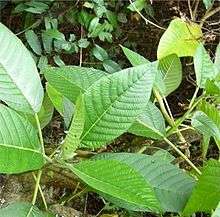Dendrocnide
| Dendrocnide | |
|---|---|
 | |
| Dendrocnide meyeniana | |
| Scientific classification | |
| Kingdom: | Plantae |
| Clade: | Angiosperms |
| Clade: | Eudicots |
| Clade: | Rosids |
| Order: | Rosales |
| Family: | Urticaceae |
| Tribe: | Urticeae |
| Genus: | Dendrocnide |
| Species | |
|
37 species | |
Dendrocnide is a genus of 37 species of shrubs to large trees in the nettle family Urticaceae. They have a wide distribution across Southeast Asia, North East India, Australia and the Pacific Islands.[1]
They are colloquially known as stinging trees,[2] stinging nettles or nettle trees. One Australian species, Dendrocnide excelsa (giant stinging tree), can grow to over 40 metres in height, but the dangerous Dendrocnide moroides (gympie-gympie) is only shrub-size.
In Vanuatu, where Dendrocnide species are known by the Bislama name nanggalat[3] or under commonly used alternative spelling nangalat,[4] they have various customary uses, including the whipping of those found guilty of breaking taboos. The pain caused by merely touching the nanggalat is no worse than the sting of a common European nettle, but far more persistent, returning whenever the affected area of skin is touched by water or rubbed, an effect that may last for days.
Dendrocnide species are used as food plants by the larvae of some Lepidoptera species, including Aenetus scotti.
Selected species
- Dendrocnide sinuata
- Dendrocnide corallodesme
- Dendrocnide cordata
- Dendrocnide excelsa, giant stinging tree
- Dendrocnide meyeniana, lipa tree
- Dendrocnide moroides, gympie gympie
- Dendrocnide peltata
- Dendrocnide photinophylla, shiny-leaved stinging tree
References
- ↑ ABRS Flora of Australia Online Search Results Archived September 29, 2007, at the Wayback Machine.
- ↑ "The Australian Plant Names Index".
- ↑ T. Crowley, A New Bislama Dictionary, p. 335
- ↑ http://www.dailypost.vu/content/tourist-claims-compensation-nangalat-leaf-burns Vanuatu Daily Post
Further reading
- Stewart, Amy (2009). Wicked Plants: The Weed that Killed Lincoln's Mother and Other Botanical Atrocities. Etchings by Briony Morrow-Cribbs. Illustrations by Jonathon Rosen. Algonquin Books of Chapel Hill. ISBN 978-1-56512-683-1.